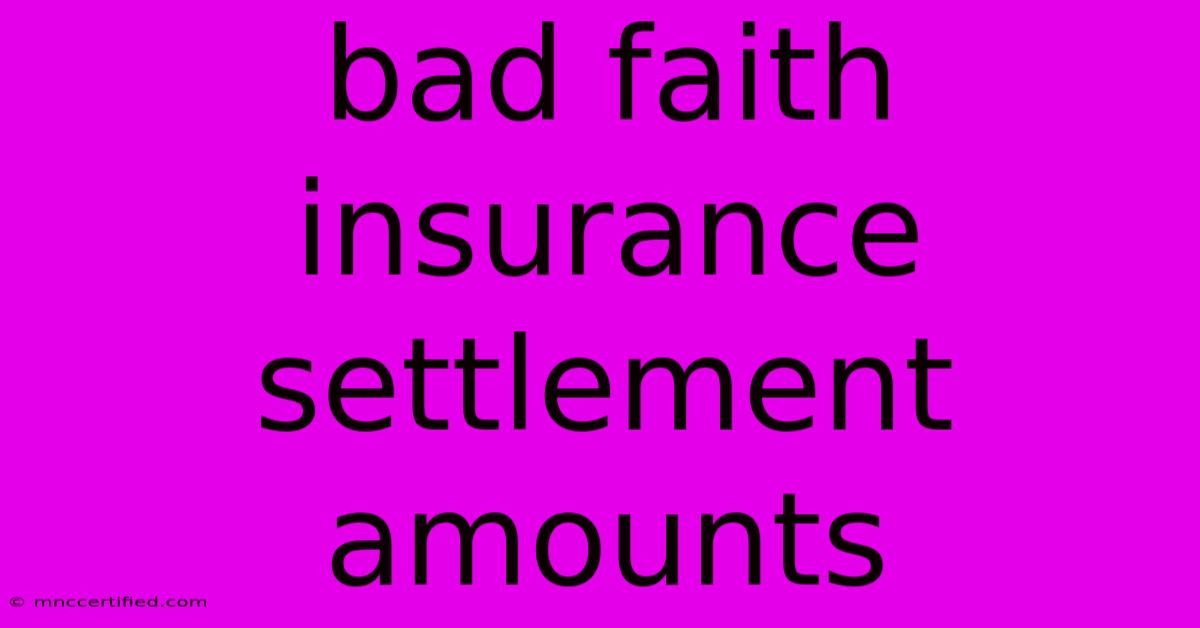Bad Faith Insurance Settlement Amounts

Table of Contents
The Unfair Game: Spotting Bad Faith Insurance Settlement Amounts
Dealing with insurance claims can be a stressful and confusing process. But when you feel like your insurance company isn't playing fair, it can feel downright frustrating. This is especially true if you suspect they're offering a bad faith insurance settlement amount – a figure that undervalues your losses.
This article will guide you through the red flags to watch out for and the steps to take if you believe your insurer is acting in bad faith.
Understanding Bad Faith Practices
Bad faith insurance practices occur when an insurance company deliberately acts in a way that violates its contractual obligations to its policyholders. This can include:
- Lowballing: Offering a settlement amount significantly lower than the actual value of your losses.
- Unreasonable Delays: Prolonging the claims process with unnecessary delays and paperwork.
- Denying Legitimate Claims: Rejecting claims without proper justification.
- Misrepresenting Policy Coverage: Providing misleading information about what your policy covers.
Identifying Bad Faith Settlement Amounts
Here are some key signs that your insurance settlement offer might be a bad faith tactic:
- Insufficient Investigation: The insurer doesn't conduct a thorough investigation of your claim and fails to gather adequate evidence.
- Ignoring Medical Records: Disregarding medical records or evidence supporting the severity of your injuries.
- Unrealistic Expectations: Pressuring you to settle quickly for a low amount, often before all damages are fully known.
- Unjustified Deductions: Applying deductions or penalties without a legitimate reason.
- Failing to Explain Denials: Rejecting your claim without a clear explanation or justification.
What to Do if You Suspect Bad Faith
If you suspect your insurer is acting in bad faith, take the following steps:
- Document Everything: Keep a detailed record of all communication with your insurance company, including dates, times, and content.
- Seek Independent Appraisals: Obtain independent appraisals for property damage or medical expenses to establish the true value of your losses.
- Consult with a Lawyer: A lawyer specializing in insurance bad faith claims can help you understand your legal rights and navigate the complexities of the process.
- File a Complaint: Report the bad faith practices to your state's insurance regulator or department.
- Consider Mediation: Mediation can be a helpful way to resolve disputes between you and your insurer without resorting to litigation.
Key Takeaways:
- Bad faith insurance practices can leave you significantly undercompensated for your losses.
- Be proactive in documenting everything and seek independent appraisals to support your claim.
- Don't hesitate to contact a lawyer if you feel your insurer is acting in bad faith.
- Know your rights and be prepared to fight for fair treatment.
Remember: Dealing with insurance claims can be overwhelming, but you don't have to go through it alone. By understanding your rights and taking appropriate action, you can protect yourself from unfair practices and ensure you receive the compensation you deserve.

Thank you for visiting our website wich cover about Bad Faith Insurance Settlement Amounts. We hope the information provided has been useful to you. Feel free to contact us if you have any questions or need further assistance. See you next time and dont miss to bookmark.
Featured Posts
-
Financial Assistance For Car Insurance
Nov 09, 2024
-
California Fleet Auto Insurance Claims
Nov 09, 2024
-
Tony Todd Candyman And Final Destination Actor Dead
Nov 09, 2024
-
Van Der Beek Opens Up About Going Into Shock
Nov 09, 2024
-
North Carolina Wind And Hail Insurance
Nov 09, 2024